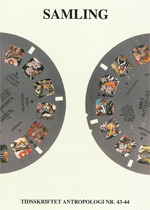DEN SIAMESISKE SAMLING I EBELTOFT
DOI:
https://doi.org/10.7146/ta.v0i43-44.107423Resumé
Rasmus Havmøller did the Siamese
Collection during the twenty years he was
a forester in Siam. In 1940, after returning
to his native Ebeltoft, Havmøller donated his
collection to the local museum. The objects
were displayed according to his wishes
and remain in much the same arrangement
today after a recent conservation of all 6-800
items. The article argues that the collection’s
musealogical interest is to be found in the
character of the presentation of the objects. In
three small rooms, filled to the brim, we meet
objects gathered by one person according to
his interests. Hunting trophies, specimens
in spirits, utensils, ceramics, stone tools
etc., mostly from Siam. The moment the
gathered objects left Siam they obtained a
quality of completion, became a whole, so to
speak, with no additions possible. This was
the number of statements or testimonies of
a foreign reality that chance and personality
had brought together: A true collection.
Accordingly, all objects are presented as
individuals of equal im-portance. Most are
provided with a factual, very brief text:
“Gold from Bang Sapan, northern Siam”,
“536 Gecco. Very common in houses, living
from insects. This specimen of medium
size”, “Fruit from the rain forest”. One meets
the objects as single and free individuals,
which speak only of themselves. Wider
contexts like Siam, or the ingenuity of the
biological world, or the life of an employee
during colonial times must be perceived
by the visitors themselves. This way of
presenting objects stands in great contrast to
many present day exhibitions. These often
consist of objects brought together from
many different sources in order to represent
an academic category which is common to
them. Such constructions hold numerous
rewards perhaps for communicating cultural
history, but in disregarding the original
context, setting, and aura of the participating
exhibits, they leave out important primary
information and remain useful, but artificial.
The object and its original background thus
may become a prisoner of the carefully lit and
coloured showcase in which it is displayed,
as well as becoming a hostage of the
educational, lengthy text that accompanies it.
To apply the simple, unconsciously adopted
principles of the 1940-displays in Ebeltoft –
one object, one text, simple appearance, no
sermons – to a modern exhibition is possible
of course, but it may meet with numerous
difficulties. Major limits are omitting what
is technically possible, and not narrating all
that one knows, reserving this knowledge
for the catalogue. Thus, the exhibit under
discussion allows the objects to appear as
they were while found, collected, and still
around us as parts of a whole, but basically
as particulars.
Downloads
Publiceret
Citation/Eksport
Nummer
Sektion
Licens
Ophavsretten til artiklerne i Tidsskriftet Antropologi tilfalder forfatteren.
Artikler publiceret i Tidsskriftet Antropologi må citeres, downloades og videresendes for ikke-kommerciel brug, under forudsætning af normal akademisk reference til forfatter(e) samt tidsskrift, årgang, nummer og sider. Artiklerne må kun genudgives med eksplicit tilladelse fra forfatter(e) og tidsskriftet.


